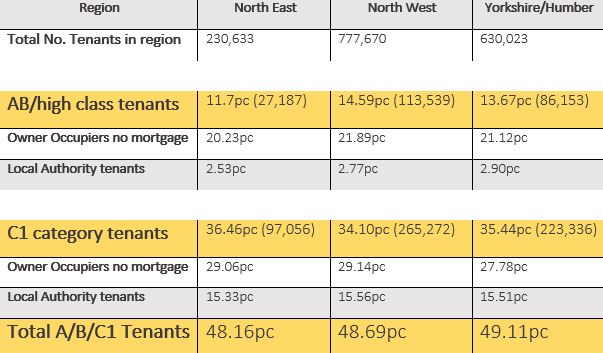Back in the 60s and 70s tenants couldn’t wait to leave their landlords and get a place of their own. Rents were sky-high and the quality of the properties weren’t very good.
However, following the introduction of Right to Buy and buy-to-let mortgages, more and more properties are being made available to younger households.
The result has been a subtle and continued shift towards higher class people, the skilled workers and professionals in the UK, to find it more feasible and beneficial to rent a property instead of waiting to buy one outright.
The image of the professional worker has long been associated with London and the south, but how do the figures shape up in the north, where the government is pushing through its goals of decreasing the ever – present north/south divide?
Today I’m looking at three regions – the north west, the north east and Yorkshire and the Humber, to see to what extent tenancies north of London consist of the higher class tenant.
Firstly, we are measuring the social class of tenants by the NRS social grade classification, widely used in the UK for market research and focused primarily on occupation and income.
If you don’t know the NRS classification system, here it is:

As we can see, the higher the grade, the bigger the income. So my figures today focus on the top three social class brackets of tenants in the north – the As, the Bs and the C1s.

We can see that the social class of a tenant in the north is essentially a coin flip – there’s an even chance of a tenant being in middle
class and the working class. To put it in perspective, the total number of A/B/C1 tenants in London is closer to 62pc.
Considering the ‘assumed’ superiority of the London housing market, and the shift towards higher class tenants in the capital, we can see that the north is quickly catching up in terms of a sustainable and highly skilled tenant population.
The fact is that private tenants are moving up the social ladder. Back in the 1960s and 70s, the private rented sector in the UK was basically viewed as a stepping stone, a temporary tenure for twentysomethings before they bought a property.
The increase in renting in London, the north and the
rest of the UK simply reflects the increasing difficulty for this group in accessing other tenures, and that the working people of today choose to rent long term instead.
This movement is only going to continue, and renting
will become a hybrid of sorts – tenants will be willing to pay more for a high quality property, wherever they are in the country. Landlords would do well to think about investing in the family stock, as the tenants are increasingly likely to marry, raise children and make a home out of their rental property going into the next ten years and beyond.




